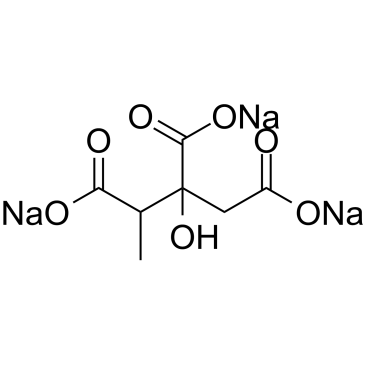2-Methylcitric acid trisodium

2-Methylcitric acid trisodium structure
|
Common Name | 2-Methylcitric acid trisodium | ||
|---|---|---|---|---|
| CAS Number | 117041-96-0 | Molecular Weight | 272.10 | |
| Density | N/A | Boiling Point | N/A | |
| Molecular Formula | C7H7Na3O7 | Melting Point | N/A | |
| MSDS | N/A | Flash Point | N/A | |
Use of 2-Methylcitric acid trisodium2-Methylcitric acid trisodium (Methylcitric acid trisodium) is an endogenous metabolite in the 2-methylcitric acid cycle. 2-Methylcitric acid trisodium accumulates in methylmalonic and propionic acidemias and acts as a marker metabolite. 2-Methylcitric acid trisodium markedly inhibits ADP-stimulated and uncoupled respiration in mitochondria supported by glutamate[1]. |
| Name | 2-Methylcitric acid trisodium |
|---|
| Description | 2-Methylcitric acid trisodium (Methylcitric acid trisodium) is an endogenous metabolite in the 2-methylcitric acid cycle. 2-Methylcitric acid trisodium accumulates in methylmalonic and propionic acidemias and acts as a marker metabolite. 2-Methylcitric acid trisodium markedly inhibits ADP-stimulated and uncoupled respiration in mitochondria supported by glutamate[1]. |
|---|---|
| Related Catalog | |
| Target |
Human Endogenous Metabolite |
| In Vitro | 2-Methylcitric acid trisodium impairs glutamate metabolism and induces permeability transition in brain mitochondria[1]. 2-Methylcitric acid trisodium inhibits glutamate dehydrogenase (GDH) activity at concentrations as low as 0.5 mM[1]. 2-Methylcitric acid trisodium (1 mM, 3 mM; 150 seconds) provokes a significant decrease in mitochondrial membrane potential and induced swelling in Ca2+-loaded mitochondria supported by different substrates[1]. 2-Methylcitric acid trisodium behaves as a potent inhibitor of glutamate oxidation by inhibiting glutamate dehydrogenase activity and as a permeability transition inducer, disturbing mitochondrial energy homeostasis[1]. 2-Methylcitric acid trisodium does not significantly impair mitochondrial glutamate transport[1]. 2-Methylcitric acid trisodium does not significantly impair glutamate mitochondrial transport in liver mitochondria[1]. |
| References |
| Molecular Formula | C7H7Na3O7 |
|---|---|
| Molecular Weight | 272.10 |
| InChIKey | HPLKAWNRQOHUKD-UHFFFAOYSA-K |
| SMILES | CC(C(=O)[O-])C(O)(CC(=O)[O-])C(=O)[O-].[Na+].[Na+].[Na+] |
| RIDADR | NONH for all modes of transport |
|---|
|
The tumour suppressor LKB1 regulates myelination through mitochondrial metabolism.
Nat. Commun. 5 , 4993, (2014) A prerequisite to myelination of peripheral axons by Schwann cells (SCs) is SC differentiation, and recent evidence indicates that reprogramming from a glycolytic to oxidative metabolism occurs during... |
|
|
Effect of 2-methylcitrate on citrate metabolism: implications for the management of patients with propionic acidemia and methylmalonic aciduria.
Pediatr. Res. 9 , 905-8, (1975) 2-Methylcitrate was tested in vitro on enzymes which interact with citrate and isocitrate. It was found to inhibit citrate synthase, aconitase, the NAD+- and NADP+-linked isocitrate dehydrogenase. Thi... |
|
|
Propionyl coenzyme A is a common intermediate in the 1,2-propanediol and propionate catabolic pathways needed for expression of the prpBCDE operon during growth of Salmonella enterica on 1,2-propanediol.
J. Bacteriol. 185 , 2802-2810, (2003) The studies reported here identify propionyl coenzyme A (propionyl-CoA) as the common intermediate in the 1,2-propanediol and propionate catabolic pathways of Salmonella enterica serovar Typhimurium L... |